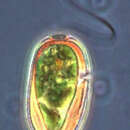en
names in breadcrumbs


Euglenaceae (also known as Euglenidae) is a family of flagellates in the phylum Euglenozoa. The family includes the most well-known euglenoid genus, Euglena.[1]
The family Euglenaceae is also known by the name Euglenidae. The origin of this dual naming system is because of the history of protists. Euglenids have been treated as both algae and protozoans, which are governed by separate nomenclature codes.[2] If classified as an alga, it would fall under the International Code of Botanical Nomenclature (ICBN) and its correct name would be Euglenaceae; if classified as a protist, it would fall under the International Code of Zoological Nomenclature (ICZN) and would be called Euglenidae.[1] Euglenids such as these are considered to be ambiregnal protists due to their parallel naming systems.[2]
Euglenaceae show the most morphological diversity within the class Euglenophyceae.[3] They are mostly single-celled organisms, except for the genus Colacium. They are free-living or sometimes inhabiting the digestive tracts of animals.[1] Two genera, Strombomonas and Trachelomonas produce outer shells called loricae.[4]
As with other euglenids, cells in the Euglenaceae are surrounded by a series of proteinaceous strips called the pellicle; the pellicle can stretch in most genera, allowing the cell to contract, creating a type of movement called metaboly. The genus Monomorphina is rigid or slightly metabolic.[1] Chloroplasts are present in most species, except for a few species that have lost them.[1] Chloroplasts are diverse in this family, with the size, number, and presence of pyrenoids being important identifying characteristics.[1]
In its current circumscription, Euglenaceae is monophyletic.[4] Its sister family is Phacaceae, which contains several genera (Lepocinclis, Phacus, and Discoplastis) formerly included within Euglenaceae.[4] Two phylogenies are shown below.
In this phylogeny, most Euglena species are sister to a clade consisting of Euglenaria and Euglena archaeoplastidiata.[4]
Euglenales EuglenaceaeEuglena pro parte
Phacaceae (outgroup)
This phylogeny places Euglena as sister to all other genera in Euglenaceae except for the genus Euglenaformis.[5]
Euglenales EuglenaceaeEuglena pro parte
Phacaceae (outgroup)
Euglenaceae (also known as Euglenidae) is a family of flagellates in the phylum Euglenozoa. The family includes the most well-known euglenoid genus, Euglena.
Euglenaceae es una familia de protistas flagelados, comúnmente presentes en agua dulce, en especial cuando ésta es rica en materia orgánica.[1][2] Suelen ser fotosintéticos aunque también se incluyen otras especies que secundariamente han perdido los cloroplastos. Son biflagelados, pero presentan un solo flagelo emergente, pues el segundo es muy corto y no sobresale del bolsillo apical. Las especies de esta familia son solitarias o coloniales y presentan uno o varios cloroplastos de gran tamaño y de diversas formas, con o sin pirenoide.[3]
Euglenaceae es una familia de protistas flagelados, comúnmente presentes en agua dulce, en especial cuando ésta es rica en materia orgánica. Suelen ser fotosintéticos aunque también se incluyen otras especies que secundariamente han perdido los cloroplastos. Son biflagelados, pero presentan un solo flagelo emergente, pues el segundo es muy corto y no sobresale del bolsillo apical. Las especies de esta familia son solitarias o coloniales y presentan uno o varios cloroplastos de gran tamaño y de diversas formas, con o sin pirenoide.
Les Euglenaceae, les euglénacées ou eugléniens en français, est une famille de flagellés de l'ordre des Euglenida.
Le nom vient du genre type Euglena, composé du préfixe latin eu- « vrai, bon », et du grec γληνη / glene, « prunelle de l'œil, pupille », le mot grec ευγληνος / evglinos signifiant « aux belles prunelles ; aux beaux yeux », probablement en référence à la ressemblance de cet organisme avec un œil.
Les Euglenaceae, les euglénacées ou eugléniens en français, est une famille de flagellés de l'ordre des Euglenida.
Euglenaceae is een familie in de taxonomische indeling van de Euglenozoa. Deze micro-organismen zijn eencellig en meestal rond de 15-40 mm groot.[1]
Bronnen, noten en/of referenties